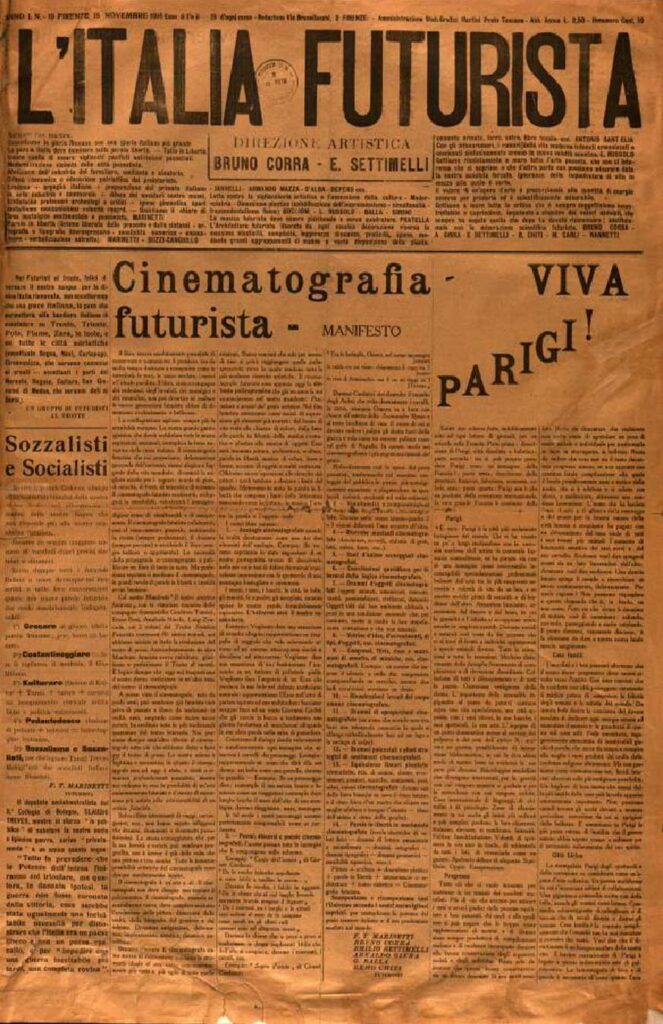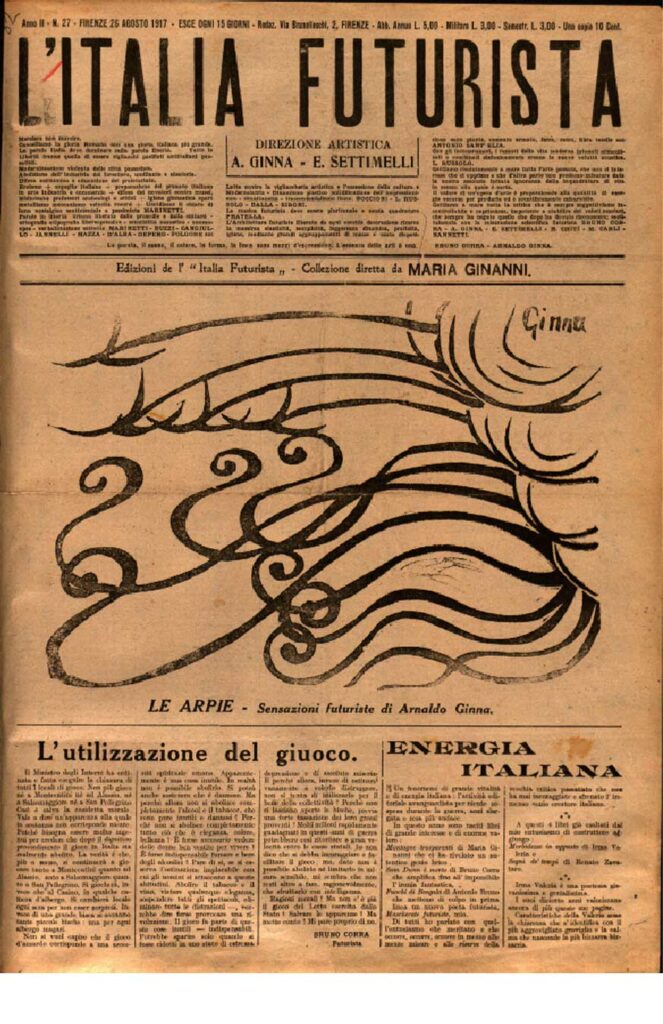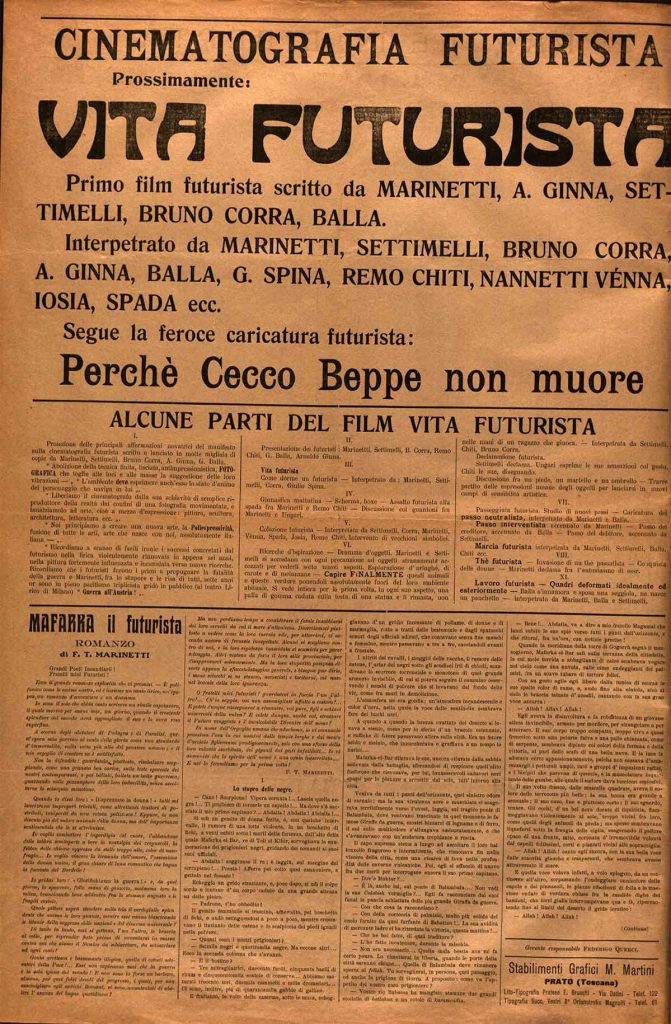
L’ITALIA FUTURISTA’ MAGAZINE,
1 JUNE 1916 – 11 FEBRUARY 1918
‘L’Italia futurista will be the first dynamic Italian newspaper’ – this is how it was announced by Emilio Settimelli as one of the most important Futurist magazines.
In the first issue of 1 June 1916, Corra, along with Settimelli, Chiti and Carli, announced: “Let us resolutely throw overboard all past art, which does not interest us, which oppresses us and which, besides, we cannot measure given our absolute forced ignorance of the framing of life in the midst of which it arose.”
And again, as Corra and Ginna wrote in the publications since 1917: “Word, sound, colour, form, line boundaries are means of expression. The essence of the arts is one”.
And so began the adventure of ‘L’Italia futurista’, with its 51 publications up to 11 February 1918, involving Marinetti, Buzzi, Cangiullo, Jannelli, Mazza, D’Alba, Depero, Boccioni, Russolo, Balla, Pratella, Corra, Ginna, Settimelli, Carli, Chiti, Conti, Nannetti, Sironi, Notte and many others. One of the most significant features of ‘L’Italia futurista’ is the high percentage of female contributors including: Maria Crisi Ginanni Corradini, Ginna’s wife, Fulvia Giuliani, Irma Valeria, Rosa Rosà, Eva Kuhn Amendola alias Magamal, Emma Marpillero, Enif Robert, Mina della Pergola, Fanny Dini, Enrica Piubellini and Marj Carbonaro.
Another extraordinary aspect is that most of the group surrounding ‘L’Italia futurista’ shared an interest in the paranormal and the occult.

Ginna and Corra, as well as actively contributing black futurist content, took turns with Settimelli in the editorial direction. Among other contributions, Ginna and Corra published the Manifesto of Futurist Science (in no. 2 of 1916) and the Manifesto of Futurist Cinematography (in no. 10 of 1916), as well as parts of the book ‘Painting of the Future’ (1917), documents that reflected the importance of the occult in science and art.
The latter was a four-sided magazine containing numerous articles, advertisements, poems, posters, drawings, photos and above all ‘Parole in libertà’ to which the third side was dedicated.
The magazine ‘L’Italia Futurista’ is beautifully illustrated, and you may find copies of all its issues, in the database developed within the framework of the PRO FIRENZE FUTURISTA Project realised, in February 2010 at the end of the centenary of the foundation of Futurist manifesto, by the library of the Kunsthistorisches Institut in Florenz – Max-Planck-Institut (1). Both Florence, a historically significant place for Futurism, and the library’s exceptional collection offered the opportunity to examine this multifaceted movement in greater detail and to build a database in which previously difficult-to-access research materials are now made available for the first time online and free of charge The library’s collection, which started in 1955, now consists of over 500 futuristic works and 40 journals from the early, ‘heroic’ years of WWI (1909-1916) and the second phase circa 1944.
The PRO FIRENZE FUTURISTA project presents a database that is currently under construction, the core of which is the full-text digitisation of the Florentine magazine ‘L’Italia futurista’. It is possible to search, on the basis of people, places and keywords in terms of content, in the database by searching both the magazine ‘L’Italia futurista’ and subsequently additional materials such as letters, books, photographs, theatre librettos, drawings, film and audio material from the library’s collection and other archives in Florence. An interactive map (currently under construction) of the city of Florence makes it possible to visualise the centres of action of the Florentine Futurists and the locations of institutions in Florence still connected with Futurism.

Florence was not only the publication site of the magazine ‘L’Italia futurista’, but also one of the most important centres of Italian Futurism along with Milan and Rome.
As a result, young Florentines joined Futurism and Florence became the scene of numerous Futurist events.
In December 1912, Ginna exhibited his two abstract paintings ‘Nevrastenia’ (1908) and ‘Passeggiata Romantica’ (1909) in the rooms of the ‘Società di Belle Arti di Firenze’ in Via della Colonna 4.
The magazine ‘Lacerba’ was founded in January 1913 by Papini, Soffici and Palazzeschi. In the same year, the group surrounding ‘Lacerba’ organised the Futurist exhibition ‘Lacerba’ in the Gonneli Gallery, which was also visited by the very young Primo Conti. On 12 December, a Futurist Evening was held at the Verdi Theatre.
In 1916, ‘L’Italia futurista’ was founded and the famous, though unfortunately apparently lost, film ‘Vita futurista’ was shot by the group around ‘L’Italia Futurista’ (Arnaldo Ginna, Bruno Corra, Lucio Venna, Emilio Settimelli, Remo Chiti, Nerino Nannetti) together with Marinetti in the Cascine, on the banks of the Arno and in the Caffè Michelangelo. At the same time, the manifesto ‘Futurist Cinematography’ appeared in ‘L’Italia futurista’. Individual photograohs give an idea of the film: the ‘futuristic breakfast’ in the La Loggia restaurant near Piazzale Michelangelo; the ‘geometric ray dance’ and the ‘futuristic brawl’ in the Cascine park. A preview and extracts from the film were presented at the Teatro Niccoloni (prose theatre) on 28 January, 1917.
The title of the film appears in ‘L’Italia futurista’ in numerous advertisements and there is also a description of the film. On the occasion of the 100th anniversary, the film was reshot under the direction of Giovanni Maria Rossi in collaboration with the Accademia di Belle Arti di Firenze, Movie und Sound Firenze SRL and Simona Serafini.
The PRO FIRENZE FUTURISTA Project is full of information that can be consulted on this link: L’Italia Futurista – Futurismus (khi.fi.it)
- The library is one of four in the Max Plank society that make available their constantly enlarged collections on Digital Libraries Connected (DLC): an open access platform for the publication of digital documents and collections also allowing numerous options for content reuse of content and metadata, a selection of viewers, as well as various possibilities for citations and connections. These four libraries in particular are: Kunsthistorisches Institut in Florenz, Max-Planck-Institut für Bildungsforschung, Max-Planck-Institut für Rechtsgeschichte und Rechtstheorie and Max-Planck-Institut für Wissenschaftsgeschichte. In this context, the library of the Kunsthistorisches Institut in Florenz – Max-Planck-Institut make available numerous contents related to Futurism as well as ‘L’Italia futurista’.
